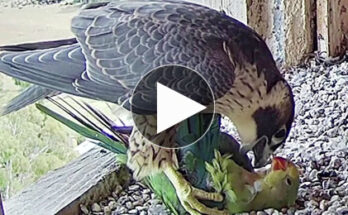A large pheasant that can be found in parts of central and eastern China. It has also been introduced to parts of Europe and can be seen in France, the Czech Republic and less commonly in the UK.

What does a Reeves’s Pheasant look like?
Male birds are highly distinctive with their white head and black masks which join together at the back of the neck. Most of the body is a vibrant golden-chestnut colour and the breast is either black or chestnut. The back has contrasting and bold black scaling, and the tails are buff-orange with a black and white patternation. The tail is the longest of any other pheasant.
Females are much less striking overall but do have a distinctive black pattern on their heads. They have buff-brown faces with dark masks. Most of the body is a mixture of brown, chestnut and a buff colour with barring. The underparts are mostly lighter; however, this is variable. The tails of a female are considerably shorter than the males.
Both adults have grey legs and short, hooked greenish bills. The eyes are brown. Males also have short spurs on their feet, which females lack.
Juveniles are mostly the same as females but have lighter forenecks and whitish-streaking on their pale brown breasts. Young males are relatively quick to get the pattern on their tails.
Reeves’s Pheasants are monotypic, but the plumage is highly variable between individuals.

How big is a Reeves’s Pheasant?
The Reeves’s Pheasant is large bird. Male birds are considerably larger than females and are an average of 210cm (82 inches) in length. The tail is one of the standout features and has been reported in older birds to reach extraordinary lengths of over 200cm. The average tail length is anywhere from 100 to 160cm (39 to 63 inches).
The tail of the male bird grows on average 30cm (12 inches) each year. This makes the tail of the Reeves’s Pheasant, the longest of all pheasants.
The average length of a female is 150cm (59 inches) with an average tail length of between 33 and 45cm (13 and 18 inches).
The wingspan is between 55 and 90cm (21 to 35 inches). The reason for the great difference in range is that males usually have a considerably larger wingspan compared to females.



